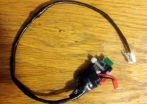(Press-News.org) University of Iowa biologist Daniel Eberl and his colleagues have shown that one of the mechanisms involved in hearing is similar to the battery in your car.
And if that isn't interesting enough, the UI scientists advanced their knowledge of human hearing by studying a similar auditory system in fruit flies—and by making use of the fruit fly "love song."
To see how the mechanism of hearing resembles a battery, you need to know that the auditory system of the fruit fly contains a protein that functions as a sodium/potassium pump, often called the sodium pump for short, and is highly expressed in a specialized support cell called the scolopale cell.
The scolopale cell is important because it wraps around the sensory endings in the fly's ear and makes a tight extra-cellular cavity or compartment around them called the scolopale space.
"You could think of these compartments as similar to the compartments of a battery that need to be charged up so they can drive electrons through circuits," says Eberl, whose paper made the cover of the journal Proceedings of the National Academy of Sciences. "In the auditory system, the charge in the scolopale space drives ions, or electrically charged atoms, through membrane channels in the sensory endings that open briefly in response to activation by sounds.
"Our work shows that the sodium pump plays a particularly important role in this cell to help replenish or recharge this compartment with the right ions. The human ear also relies on a compartment called the scala media, which similarly drives ions into the sensory cells of the ear," he says.
How was the research done? This is where the fruit fly love song comes into play.
Testing whether or not a fruit fly can hear the love song—a sound generated by a vibrating wing—enables Eberl to learn whether electrical recharging is occurring in the fly ear. The fruit fly love song played a role in the research by stimulating the fly to move whenever a sound was emitted and received.
"In these experiments we tested the fly's hearing by inserting tiny electrodes in the fly's antenna, then measuring the electrical responses when we play back computer-generated love songs," he says.
Eberl notes there are many similarities between fruit fly and human mechanisms of hearing. That means his work on the fly model to identify additional new components required for generating the correct ion balance in the ear will help scientists to understand the human process in more detail.
Eberl's co-authors on the paper are Madhuparna Roy, postdoctoral associate at the University of Pittsburgh, and Elena Sivan-Loukianova, UI biology research scientist. At the time of the research, Roy was a graduate student in the UI Graduate College studying in the College of Liberal Arts and Sciences Department of Biology.
The title of the paper, published last week, is "Cell-type-specific roles of Na+/K+ ATPase subunits in Drosophila auditory mechanosensation."
INFORMATION:
The research was supported by the National Institutes of Health (grant number 5P30DC010362-03) and the Iowa Center for Molecular Auditory Neuroscience at the UI (grant number P30DC010362).
UI researcher learns mechanism of hearing is similar to car battery
Study made use of the fruit fly 'love song'
2013-01-08
ELSE PRESS RELEASES FROM THIS DATE:
AMSSM issues position statement on sport-related concussions
2013-01-08
Philadelphia, Pa. (January 7, 2013) - Athletes with concussions must be held out of practice or play until all symptoms have resolved, to avoid the risk of further injury during the vulnerable period before the brain has recovered. That's among the key recommendations in the new American Medical Society for Sports Medicine (AMSSM) position statement on concussions in sport, which appears in the January issue of Clinical Journal of Sport Medicine. The journal is published by Lippincott Williams & Wilkins, a part of Wolters Kluwer Health.
At a time of increased concern ...
Penn researchers show new level of control over liquid crystals
2013-01-08
PHILADELPHIA — Directed assembly is a growing field of research in nanotechnology in which scientists and engineers aim to manufacture structures on the smallest scales without having to individually manipulate each component. Rather, they set out precisely defined starting conditions and let the physics and chemistry that govern those components do the rest.
An interdisciplinary team of researchers from the University of Pennsylvania has shown a new way to direct the assembly of liquid crystals, generating small features that spontaneously arrange in arrays based on ...
Computer scientists find vulnerabilities in Cisco VoIP phones
2013-01-08
New York, NY—January 7, 2013—Columbia Engineering's Computer Science PhD candidate Ang Cui and Computer Science Professor Salvatore Stolfo have found serious vulnerabilities in Cisco VoIP (voice over internet protocol) telephones, devices used around the world by a broad range of networked organizations from governments to banks to major corporations, and beyond. In particular, they have discovered troubling security breaches with Cisco's VoIP phone technology. At a recent conference on the security of connected devices, Cui demonstrated how they can easily insert malicious ...
Black and Hispanic patients less likely to complete substance abuse treatment, Penn study shows
2013-01-08
PHILADELPHIA – Roughly half of all black and Hispanic patients who enter publicly funded alcohol treatment programs do not complete treatment, compared to 62 percent of white patients, according to a new study from a team of researchers including the Perelman School of Medicine at the University of Pennsylvania. Comparable disparities were also identified for drug treatment program completion rates. The study, published in the latest issue of Health Affairs, shows that completion disparities among racial groups are likely related to differences in socioeconomic status and, ...
Obese moms risk having babies with low vitamin D
2013-01-08
CHICAGO --- Women who are obese at the start of their pregnancy may be passing on insufficient levels of vitamin D to their babies, according to a new Northwestern Medicine® study.
The study found that babies born to lean mothers had a third higher amount of vitamin D compared to babies born to obese moms.
Vitamin D is fat-soluble, and previous studies have found that people who are obese tend to have lower levels of the vitamin in their blood. In this study, both obese and lean mothers had very similar levels of vitamin D at the end of their pregnancies, yet obese ...
Southern Medical Journal presents special issue on disaster preparedness
2013-01-08
Philadelphia, Pa. (January 7, 2013) – Surveys suggest that while most US physicians are willing to play a role in responding to natural and manmade disasters, most do not feel adequately prepared to fulfill that role. Toward helping physicians and health care systems understand and fulfill their obligation to provide medical care in disasters, the January Southern Medical Journal is a special issue on disaster medicine and physician preparedness. The official journal of the Southern Medical Association, the SMJ is published by Lippincott Williams & Wilkins, a part of Wolters ...
Study looks at how states decide which child receives early intervention for developmental problems
2013-01-08
AURORA, Colo. (Jan. 7, 2013) A new study out by researchers at the University of Colorado School of Medicine, found large differences in the criteria that states use to determine eligibility for Part C early intervention services for infants and toddlers who have developmental delays. A developmental delay is any significant lag in a child's development as compared with typical child development.
Current eligibility criteria for Part C services vary from state to state. With their colleagues, Steven Rosenberg, PhD, associate professor, University of Colorado Department ...
At least 1 in 6 stars has an Earth-sized planet
2013-01-08
The quest for a twin Earth is heating up. Using NASA's Kepler spacecraft, astronomers are beginning to find Earth-sized planets orbiting distant stars. A new analysis of Kepler data shows that about 17 percent of stars have an Earth-sized planet in an orbit closer than Mercury. Since the Milky Way has about 100 billion stars, there are at least 17 billion Earth-sized worlds out there.
Francois Fressin, of the Harvard-Smithsonian Center for Astrophysics (CfA), presented the analysis today in a press conference at a meeting of the American Astronomical Society in Long Beach, ...
Exocomets may be as common as exoplanets
2013-01-08
Comets trailing wispy tails across the night sky are a beautiful byproduct of our solar system's formation, icy leftovers from 4.6 billion years ago when the planets coalesced from rocky rubble.
The discovery by astronomers at the University of California, Berkeley, and Clarion University in Pennsylvania of six likely comets around distant stars suggests that comets – dubbed "exocomets" – are just as common in other stellar systems with planets.
Though only one of the 10 stars now thought to harbor comets is known to harbor planets, the fact that all these stars have ...
People with diabetes in Ontario getting fewer government-funded eye exams, new study finds
2013-01-08
TORONTO, Jan. 7, 2013—A new study has found that adults with diabetes in Ontario are getting significantly fewer government-funded eye exams than they were a decade ago, a key component of high-quality diabetes care essential to preventing diabetes-related eye complications.
The decrease is an unintended consequence of the provincial government's decision in 2004 to delist routine eye exams from the Ontario Health Insurance Plan for healthy adults under age 65, said lead researcher Dr. Tara Kiran.
Routine eye exams continue to be funded for adults with diabetes and other ...
LAST 30 PRESS RELEASES:
Drone sampling of whale breath reveals first evidence of potentially deadly virus in Arctic
Roman soldiers defending Hadrian’s Wall infected by parasites, study finds
Pinochet’s prisoners were tormented with music but still found solace in it, a new book reveals
Fertility remains high in rural Tanzania despite access to family planning
AI-assisted device can improve autism care access
Kinetic careers
Uncovering how parasitic plants avoid attacking themselves to improve crop resistance
Nanoparticle vaccine strategy could protect against Ebola and other deadly filoviruses
Study finds brain care score can predict risk of stroke across racial groups
Key lung immune cells can intensify allergic reactions
Do hormones explain why women experience more gut pain?
New materials conduct ions in solids as easily as in liquids
Breakthrough of the Year: Renewable energy begins to eclipse fossil fuel-based sources
LLM use is reshaping scientific enterprise by increasing output, reducing quality and more
Introducing LightGen, a chip for ultra-fast, ultra-efficient generative AI
Astronomers see fireworks from violent collisions around nearby star
ACC/AHA issue new guideline on managing congenital heart disease in adults
Cosmic crash caught on camera
Is talented youth nurtured the wrong way? New study shows: top performers develop differently than assumed
Ants: An untapped resource in the development of antibiotics?
Archaeologists use AI to create prehistoric video game
Mitochondria migrate toward the cell membrane in response to high glucose levels
Tiny viral switch offers hope against drug-resistant bacteria
Most parents aware of early peanut introduction guidelines, but confused about details
HPV vaccine can protect against severe lesions of the vulva and vagina
Virtual care provision and emergency department use among children and youth
Quadrivalent HPV vaccine and high-grade vulvovaginal lesions
Insights into dry eyes gained from stem cell-derived tear glands
Researchers identify 166 human pluripotent stem cell lines available for use in clinical applications
Europa Clipper instrument uniquely observed interstellar comet 3I/ATLAS
[Press-News.org] UI researcher learns mechanism of hearing is similar to car batteryStudy made use of the fruit fly 'love song'




